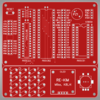vladimir520
New Member
Tried making a list with alternatives for this YouTuber's 6502 kit. While my list would have looked a lot better and complete, I accidentally clicked away and lost all my progress so I'm out of nerves. Sorry for copy pasting links.
I would like to know if the items on my list are alright.
breadboard: 6 of these: this
CPU: only found 6502 at a low price: this
Versatile Interface Adapter: only found 6522: **broken link removed**
EEPROM: **broken link removed**
SRAM: this
LED Display: from a local store, it's in Romanian, it's alright: https://roboromania.ro/produs/lcd-2x16-caractere-led-blue-display/
NAND Gate: this
crystal oscillator: sadly only found this... which is at 16Mhz and not at 1Mhz... this might be a tad too expensive
tact switches: this
LEDs: this should do lol: **broken link removed**
potentiometer: https://www.aliexpress.com/item/400...chweb0_0,searchweb201602_9,searchweb201603_53
resistors: not a problem, they're way too cheap
capacitor: https://www.aliexpress.com/item/329...chweb0_0,searchweb201602_9,searchweb201603_53
wires: https://www.aliexpress.com/item/328...chweb0_0,searchweb201602_9,searchweb201603_53
I'll look for hookup wires later, I guess.
I would like to know if the items on my list are alright.
breadboard: 6 of these: this
CPU: only found 6502 at a low price: this
Versatile Interface Adapter: only found 6522: **broken link removed**
EEPROM: **broken link removed**
SRAM: this
LED Display: from a local store, it's in Romanian, it's alright: https://roboromania.ro/produs/lcd-2x16-caractere-led-blue-display/
NAND Gate: this
crystal oscillator: sadly only found this... which is at 16Mhz and not at 1Mhz... this might be a tad too expensive
tact switches: this
LEDs: this should do lol: **broken link removed**
potentiometer: https://www.aliexpress.com/item/400...chweb0_0,searchweb201602_9,searchweb201603_53
resistors: not a problem, they're way too cheap
capacitor: https://www.aliexpress.com/item/329...chweb0_0,searchweb201602_9,searchweb201603_53
wires: https://www.aliexpress.com/item/328...chweb0_0,searchweb201602_9,searchweb201603_53
I'll look for hookup wires later, I guess.


